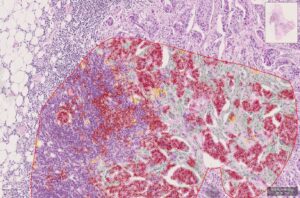Trying to find a reproducible way for assessment TILs in Triple negative breast cancer (TNBC).
In breast cancer, tumor-infiltrating lymphocytes (TILs) are a predictive and prognostic factor, particularly in Triple-negative breast cancer (TNBC). TILs assessment is thought to be significant in TNBC, which has different subtypes and outcomes. In my project, I am evaluating TILs and investigating their impact on survival.
While assessing the TILs, I take into account the guidelines of the International TILs working group. It defines TILs are classified into two types; intratumoral TILs and stromal TILs. I examined the stromal TILs for each case in our dataset (Figure 1). I scored them between 0% and 100%. TILs within the borders and between tumor nests, and all mononuclear cells should be scored. Intratumoral TILs, polymorphonuclear cells, TILs outside the tumor or surrounding DCIS and normal lobules, areas with necrosis, and artifacts are excluded.
Recent clinical studies have shown that host antitumor immunity, as measured by TILs, is clinically important in TNBC. They showed that higher TILs levels were associated with better recurrence-free survival and treatment responsiveness. However, clinical use of TILS in breast cancer assessment remains limited in daily practice due to subjectivity and lack of standardization. Due to the inter- and intra-observer variability, the difficulty and subjectivity of quantitatively evaluating histological features, a solution is sought for this problem in clinical practice. For this reason, different groups are working to standardize TILs evaluation, especially the International Immuno-Oncology Biomarker Working Group on Breast Cancer is trying to find a reproducible way for assessment. Machine learning-based TILs analysis is being developed to mimic how pathologists assess TILs. This is another part of my project to analyze TILs using the automated TILs evaluation algorithm in an open-source QuPath platform, which provides reproducibility described previously. In the figure 2, each of the different type of cells are labeled and an objective TILs ratio is obtained as a result of this evaluation.
My next step is to define the nature of the TILs. I am working on different assays for molecular profiling of TILs and these approaches will be explained in my upcoming post.
Figure 1. Examples for TILs levels (left is 1%, right is 95 %)
Figure 2. TILs assessment algorithm (red:tumor cells, purple:TILs)
Umay kiraz – ESR11.



